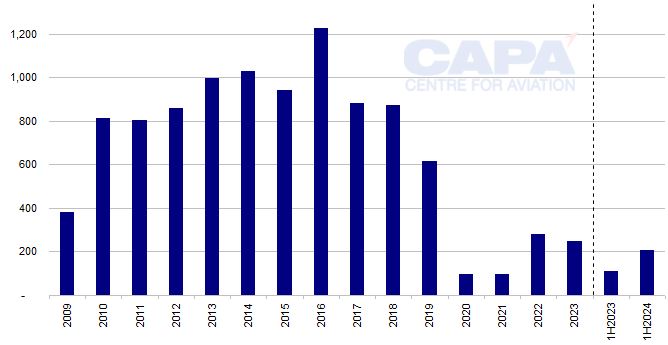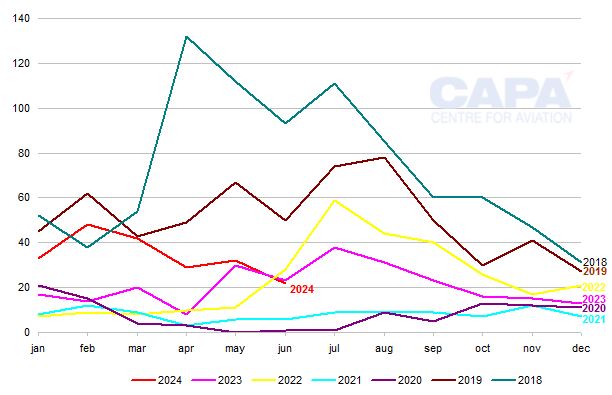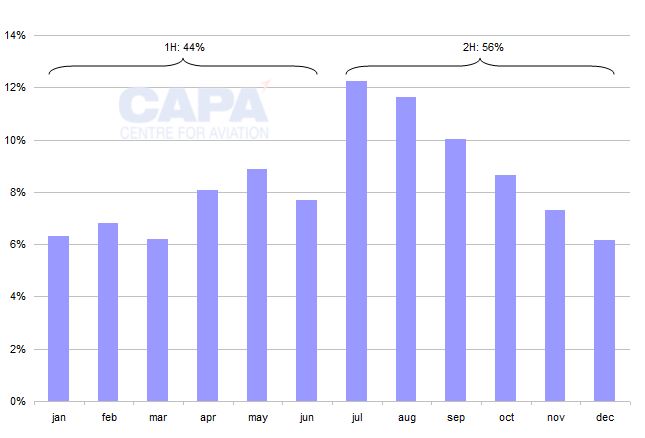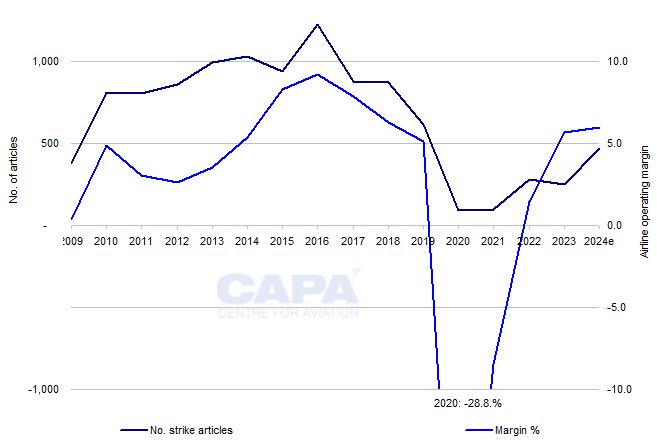Number of CAPA strike articles increases, but aviation unions remain cautious
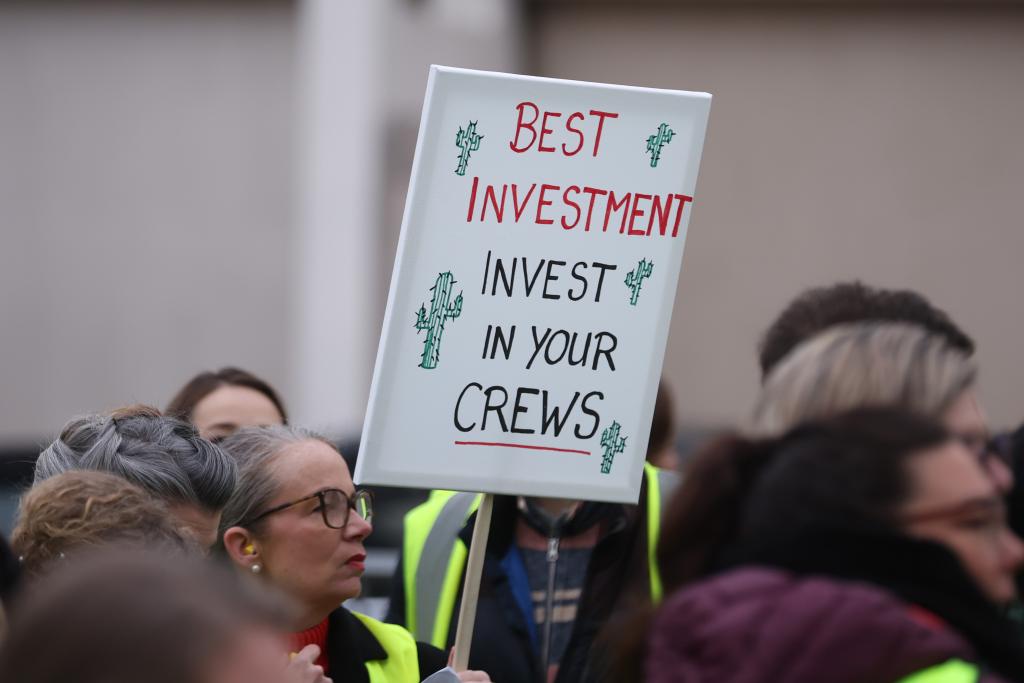
The number of strike-related CAPA articles fell to a new low during the COVID-19 pandemic
In 2016, there were 1,228 articles on the CAPA – Centre for Aviation website mentioning the word “strike”, the highest number in the period from 2009 to 2024 in which this statistic was observed.
The number then fell steadily until it reached almost half of that number in 2019, reaching 616, the lowest figure since 2009 (381).
With the COVID-19 crisis, the number of articles mentioning the topic of “strike” also decreased significantly.
In 2020 there were only 95 and in 2021 97 – by far the two lowest numbers since CAPA – Centre for Aviation – began recording the figures annually.
This is not surprising, as activity in the industry has been very low during the pandemic.
The numbers increased in 2022 but decreased slightly in 2023
In 2022, the number rose 189% year-on-year to 280, but was still low by pre-pandemic standards.
The number of articles mentioning strikes then fell to 248 in 2023, despite a significant increase in industry activity.
This was only 40% of the 2019 figure, although global passenger numbers were almost at 2019 levels.
In the first half of 2024, there was a sharp increase in strike-related articles
In H1 2024, the number increased sharply compared to the same period last year – by 84% – reaching 206. This was the highest number for the first half of the year since H1 2019, but was still well below the 316 articles for that period.
There was an increase in each month of the first half of 2024, except for the month of June 2024, when the number was 22, compared to 23 in the month of June 2023.
Labor disputes within the Lufthansa Group, particularly in the first quarter of 2024, were a key factor in the increase in the first half of 2024.
July, August and September usually have the highest number of articles
The distribution of strike-related articles throughout the year shows a seasonal pattern.
Based on the seven-year period beginning in H2 2019 and ending in H1 2024, July and August are the two months with the highest sales of such items, both accounting on average for about 12% of the annual total, while September accounts for 10%.
This seasonality is concentrated in the peak months of the northern summer, when many of the world’s largest airlines are at their busiest and generate the most revenue.
Overall, 44% of the articles were posted in the first half of the year and 56% in the second half of the year (thanks to the dominance of the third quarter).
The annual number of strike articles fluctuates with the airlines’ profit cycle
Since 2009, the number of CAPA (Centre for Aviation) articles containing the word “strike” and the annual operating profit margin of the global aviation industry have been tracked.
Throughout this period there was a strong correlation between these two variables.
This seems to make intuitive sense.
As the profit cycle approaches its peak, workers typically become more demanding for a larger share of the profits.
When the aviation industry faces major economic challenges, however, unions’ bargaining power is limited and the focus is on preserving jobs. When airlines are at the bottom of their profit curve, strikes are therefore extremely rare.
The previous low point in the number of strike-related articles was reached in 2009 during the global financial crisis, when the airline industry’s operating margin was only 0.4 percent.
In 2020, the new record low of just 95 strike-related items coincided with a record negative operating margin of -28.8% for the global aviation industry.
Operating margin improved to -8.9% in 2021, but was still well below any previous economic low, and the number of articles mentioning strikes remained very low.
In 2022, the margin increased to 1.5% and the number of items also increased significantly to 280.
However, the margin increase to 5.7% in 2023 was also accompanied by a slight decrease in the number of strike-related items.
The COVID-19 pandemic and its immediate aftermath may have loosened the link between margins and strikes.
However, the increase in strike-related articles in the first half of 2024 suggests that the labor side is resuming its relations and industrial relations are returning to the level they would have been without the pandemic.
2024: Small improvement in the forecast margin – and increase in strike articles?
IATA forecasts a slight improvement in global airline operating margins to 6.0% in 2024 (from 5.7% in 2023).
It is extremely difficult to predict the number of strike-related articles. The results of previous years suggest that the number could increase in 2024 as well. This is definitely the case in the first half of 2024.
At this point in the year, it seems extremely unlikely that the total for 2024 will return to the ten-year average of 905 from 2010 to 2019, or even the level of 616 from 2019.
However, the seasonality pattern can provide some clues. If the distribution of items in 2024 is the same as the average of previous years, one could expect 56% of items to fall in the second half of 2024.
After 206 in the first half of 2024, that would be 262 articles in the second half of 2024, making a total of 468 for the year this year.
While this would be the highest total since 2019, it would still be well below this year’s 616 items, although the forecast margin is higher this year than in 2019.
This is not a forecast, but the following graph considers the number 468 as an example projection for the year 2024.
Strike-related articles cover a range of regions and sectors of aviation
CAPA – Centre for Aviation news articles containing the word “strike” in H1 2024 covered a wide range of geographic areas and different parts of the aviation supply chain.
An important source of these articles are airlines, especially flight attendants and pilots, but also air traffic control, ground handling, parking management and airports are represented.
Companies mentioned in the articles over the past two months include Lufthansa Group airlines, Aer Lingus, WestJet, Air Transat, American Airlines, Aeromexico, Aerolineas Argentinas, London Heathrow Airport, Avinor, Norwegian, French air traffic controllers and UK Border Agency staff.
These articles cover situations where strikes have been averted, settled, or are only a future possibility, as well as strikes that are already underway.
Labour has regained some confidence but remains more cautious than in the past
Strike-related activity – and the number of articles reporting on it – was muted in June 2024 after increasing sharply throughout much of the first half of 2024.
Nevertheless, an increase in 2024 compared to the 2023 annual total appears likely. The period between July and September will be crucial for the extent of the increase, provided current seasonal patterns continue.
Since the pandemic, workers have regained some confidence. However, the number of industrial action disputes has not yet returned to pre-pandemic levels, despite forecasts above 2019 levels.
As CAPA – Centre for Aviation suggested in its earlier analysis of the number of strike-related articles in August 2023, workers still appear to be more cautious than at similar points in the earnings cycle in the past.
Related Posts

An Iowa call to action on smartphones and social media

Further flight cancellations over the long weekend due to strikes: WestJet


